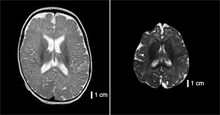Are Human Brains Still Evolving? Brain Genes Show Signs of Selection
We humans are proud of our big brains, and rightly so. Averaging 1350 cubic centimeters (cc), the human brain is proportionally larger than that of any other animal. Its highly advanced cognitive powers have spurred us to create art, build cities, and send representatives of our species into space. Just why natural selection blessed us with these talents is poorly understood. But the fossil record and genetic studies clearly show that the evolution of higher cognition began sometime after the chimp and human lines split, some 5 million to 6 million years ago, and continued at least until the rise of modern humans, roughly 200,000 years ago.
Now two new reports on pages 1717 and 1720 of this issue suggest that the evolution of the human brain may not have stopped when Homo sapiens first came on the scene. The studies, both led by human geneticist Bruce Lahn of the University of Chicago, conclude that two genes thought to regulate brain growth have continued to evolve under natural selection until very recently—and perhaps are doing so today.
“The possibility that our brains are continuing to adapt is fascinating and important,” says Huntington Willard, director of the Institute for Genome Sciences and Policy at Duke University in Durham, North Carolina. “Most laypeople tend to assume that humans are the pinnacle of evolution and that we have stopped evolving.”
When mutated, brain genes cause microcephaly in humans (normal infant brain, left; microcephalic brain, right).
CREDIT: WILLIAM DOBYNS/UNIVERSITY OF CHICAGO
But researchers caution that although these genetic variants, or alleles, do seem to have been the target of natural selection, there's as yet little solid evidence that the advantage they confer was brain-related. “The case for selection acting on [the genes] is reasonably strong,” says anthropologist Mark Stoneking of the Max Planck Institute for Evolutionary Anthropology in Leipzig, Germany. “However, there is absolutely nothing in either paper to relate the signature of selection to any brain-related phenotype.”
Lahn's group focused on two genes, called microcephalin and ASPM, that cause primary microcephaly, a condition in which the brain is severely reduced in size. Earlier work by Lahn's group and others had shown that the human versions of microcephalin and ASPM have come under strong natural selection since the chimp-human split, implicating both genes in our ancestors' dramatic brain expansion.
Several other genes have also been identified as potential contributors to our early ancestors' evolution (Science, 8 July, p. 234). On page 1693 of this issue, Ajit Varki of the University of California, San Diego, and his colleagues add another to the list: They report that a gene expressed in microglia, immune cells of the nervous system, produces a protein found only in humans. This suggests that it too has been the target of selection during human evolution, and that human microglia are specialized compared to those of chimps.
In their new research, Lahn and his co-workers looked for evidence that selection had operated on microcephalin and ASPM much more recently—since the rise of modern humans. The team sequenced the DNA of about 90 human cells housed at the Coriell Institute for Medical Research in Camden, New Jersey, whose cell collection is broadly representative of global human diversity. For each gene, they found an allele with a surprisingly high frequency in human populations. Statistical tests showed that these frequencies are unlikely to be due to random genetic drift or population migration, suggesting that the alleles were instead favored by natural selection. Making assumptions about past mutation rates, the team then estimated when each allele arose. The favored microcephalin allele clocked in at 37,000 years ago (with confidence intervals ranging from 14,000 to 60,000 years)—about the time of the explosion of symbolic behavior in Europe. The ASPM allele arose 5800 years ago (with a possible range of 500 to 14,100 years), just before cities arose in the Near East.
Lahn's team argues that in the case of ASPM in particular, the young age of the selected allele and its worldwide distribution suggest that it was subject to a strong “selective sweep” in the very recent past. Lahn says these alleles may have provided an adaptive advantage in some brain-related function, possibly although not necessarily cognition. His group is now collaborating with others to see if living people with the alleles have some sort of cognitive advantage. The team has also taken out patents on both genes, which will cover tests to see whether an individual carries the favored alleles.

Certain forms of two brain genes may confer a selective advantage.
CREDIT: PHOTODISC BLUE/GETTY IMAGES
Despite these potentially dramatic findings, many researchers who spoke to Science were unwilling to immediately accept all of the Lahn team's conclusions. The data do bear the fingerprints of natural selection, says geneticist Chris Tyler-Smith of the Sanger Institute near Cambridge, U.K. But he questions whether that selection was acting upon the brain or some other function. Both genes are expressed in tissues other than the brain, although previous studies have shown that their expression is strongest in the developing brain of mice and humans.
Even if the favored alleles did provide some sort of cognitive or cultural advantage, some researchers say that it was unlikely to have been a dramatic one. All normal modern humans are capable of language and symbolic expression, regardless of which alleles they have. “This suggests that the new alleles don't have a big effect on these abilities,” says Tyler-Smith, who calls the possible links to events in human prehistory “highly speculative.”
Lahn and colleagues also found a pronounced pattern in the distribution of the favored alleles in populations around the world: The microcephalin allel, for example, is much more common in Europe, Asia, and the Americas than in sub-Saharan Africa. Using a larger sample from 1184 individuals, the team found this allele in roughly 75% or more of Italians, Russians, and Han Chinese, and in nearly 100% of Colombians. In contrast, the allele had frequencies of less than 10% in the Zime of Cameroon and the San of Namibia, and about 30% of Tanzanian Masaai. The ASPM allele also showed a skewed geographic distribution.
Lahn and his co-workers say that several scenarios could account for the pattern. For example, the favored alleles may have arisen outside Africa, or they may reflect a genetic “bottleneck” that occurred when a relatively small founding population carrying the alleles migrated out of Africa.
The possibility that the favored alleles might confer some sort of cognitive edge—and that they are unevenly distributed in human populations—raises social and ethical issues, researchers say. Lahn warns that there is “a lot of potential for over- and misinterpretation” of his results. He points out that other advantageous alleles might have a very different population distribution. “You don't necessarily come out ahead” if you have these alleles, Lahn says: “We only picked out two.”
Although they acknowledge such social concerns, most scientists who spoke to Science say that the only way to answer the questions posed by this research is to do more research. “We should treat these genes just like any others,” says Tyler-Smith.




